Abandoned in 1927 and left to ruin for almost a century, it took a team of brave (or foolhardy?) developers to decide that Bodmin Jail had the potential to become a hotel and tourist attraction. Bats, pigeons, neighbouring builders and covid-19 ensured that realising their vision was easier said than done. Thomas Lane reports

For almost 100 years the small Cornish town of Bodmin’s most distinctive local landmark has been a ruined jail. Visible from many parts of the town, the prison features massive granite walls with an unusual ventilation chimney at the junction of its two wings.
Abandoned in 1927 and sold for demolition, attempts were made to blow it up for the stone, but the one metre-thick walls proved too much for the explosives of the day. The roof was removed, though, and it has sat there gently crumbling ever since; festooned with ivy and colonised by bats and pigeons until a Russian entrepreneur was out for a walk six years ago, saw the building, fell in love and bought it.
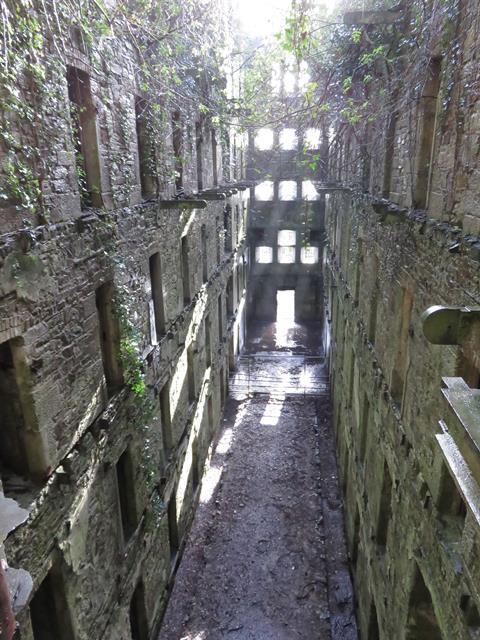
Initially, Mallino Developments – who, depending on one’s point of view, were either brave or foolhardy – made the decision to buy the ruin and create a visitor attraction themed around the prison’s history. As this used only a small corner of the site, Mallino then decided to turn the former cells and administration rooms into a hotel.
Bodmin is an unlikely location for potentially such a large hotel, given the size of the town and its central Cornwall location away from the coast. Rob Cox, the managing director of Mallino, explains why the developer decided to take the plunge.
“Bodmin is the very centre of Cornwall,” he explains. “It is equidistant between the coasts, right on the A30, and a town we see as having real potential and a reason to invest in. We genuinely think it is a great little town; it just needs an anchor and a focus and we hope we can provide that.”
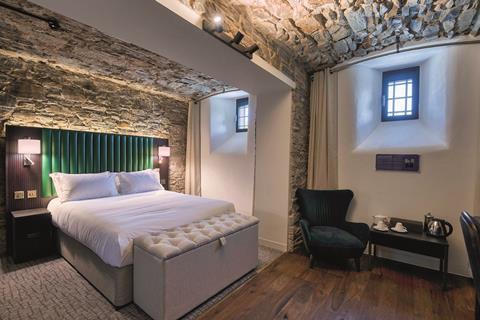
Realising this vision was easier said than done. The two wings had been exposed to the elements for nearly 100 years, which meant nothing was left except the walls. These were damaged by explosives, and the builders of a small housing estate high above the prison had got rid of the spoil from the development by the simple expedient of tipping it over the edge, down onto the prison, burying the walls of the north side of one wing up to the third floor. The old walls were crawling with bats, which are heavily protected, making construction work a challenge – plus the building was listed.
The scale of the task, combined with its remote location and the clients’ desire to realise their vision as soon as possible, meant finding a contractor to take the job on was almost impossible, as David Hall, director of operations of project manager TPI who had been engaged by Mallino to get the job off the ground, explains.
A tough regime in a healthy environment
Bodmin Jail was built in 1779 according to the principles of the prison reformer John Howard, who believed in a tough regime in a healthy environment. It was one of the first prisons to feature individual cells for prisoners and segregated areas for men and women.
In 1850 the jail was declared unfit for purpose and a new, 220-cell prison was built on the same site.
In 1859 the elaborate ventilation system was introduced whereby stale air was extracted from cells in a series of ducts terminating in a massive chimney which expelled the air.
From 1877 one of the two wings was used to house naval prisoners.
Hangings took place in the prison, with the last one taking place in 1909. The prison then began to be wound down, with the women’s section closing in 1911 and the male civil wing closing in 1915. The prison closed in 1927, with the wings stripped of the contents and the roof for salvage.The administration block was left intact.
The original hanging area was opened as a visitor attraction last October for a month, when 12,000 visitors passed through the doors before it had to close because of the pandemic.
“Economically and commercially, this was a huge project to be undertaken in Cornwall,” he says. “One of our concerns was the capacity and capability of the local supply chain to manage what was a very complex project with a very aggressive programme to deliver a high-quality building and still make commercial sense at the end of it.”

To speed things up TPI decided to involve a contractor, CField, with which it had worked previously and knew and trusted. “The reason we invited CField to come down was because we felt there was a need to move very quickly on a very complex job where there was no certainty on the programme or what the cost of construction was likely to be at the time we got in touch with them,” explains Hall.
“Therefore we felt that we needed a contractor that we could trust in terms of being to negotiate openly with, but also their capacity to deliver what would be a very complex job at site level.”
CField are from Cork, with a presence in London, so Cornwall is a long way to go for a job. For Sheila Gisler, the firm’s chief executive, the only reason for considering this job was the relationship with TPI.
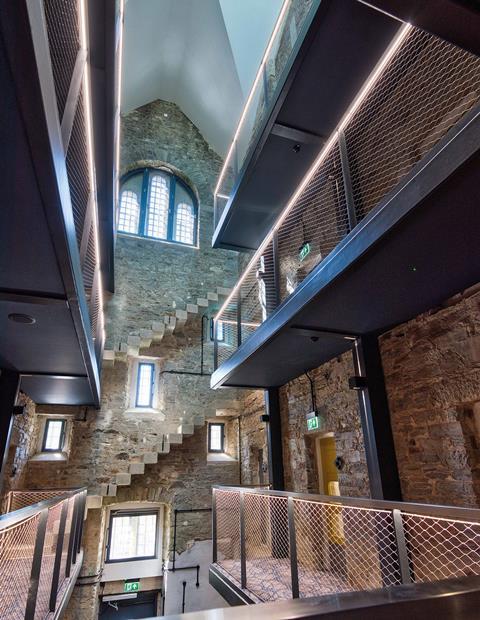
“The reason CField are on the job is entirely because of TPI – we have a great working relationship,” she explains. “If someone we didn’t know had asked us to come down and look at this job, we probably wouldn’t have done it.”
Having taken on the job, CField started work in September 2019 with the objective of finishing by the end of October 2020. It quickly became evident that the bats were going to be a major issue for the team. If a bat was discovered, work in that area and on either side had to stop immediately.
“Every nook or cranny where there was a bat we had to stop work on either side, which meant this would put three cells out of action,” explains Brian Greene, CField’s contracts manager, who was running the job. “It also reduced the amount of work you could do nearby because of noise, so the sequencing went out of the window and the programme suffered.”
Work could only resume once Mark Tunmore, the ecologist from Plan for Ecology, had removed the bat to a safe location. If the bats were hibernating, they had to be left until they woke up – which could take up to a week.
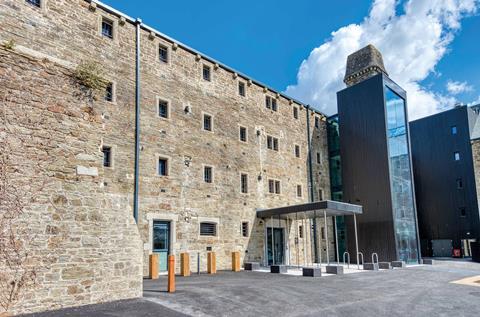
Greene says the team were discovering a bat every other day and had to move to another area of the prison to work. “It was frustrating; we lost efficiency but made up for it with effort,” he says.
The second challenge was the pigeons. “There were a lot of pigeons that were here before us and felt they owned the building – and let us know that by nesting everywhere,” says Greene.
The team decided not to harm these but to remove the nests and eggs before the fledglings emerged. “Once the fledglings were out of the eggs we were in trouble because we had to leave these,” Greene says. A couple of people were employed to patrol the building and alert the ecologist if they spotted nests being built.
Another major undertaking was dealing with the spoil that had been dumped down onto the building from the housing development above. This could not just be shifted out of the way as there was a risk of the development above collapsing onto the hotel. A 12m-high retaining wall had to be constructed first; this required 18m‑deep piles and took over a year to construct.
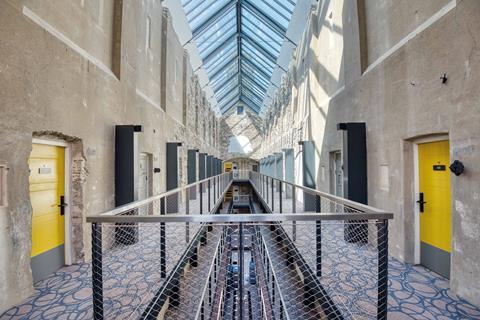
Each bedroom consists of three former prison cells, two for the bedroom and one for the bathroom. This necessitated making a large opening between two cells to form one big space, and a door into the bathroom. The internal walls are 600mm thick and feature a rubble infill sandwiched between two outer stone skins.
The walls had to be injected with grout to stabilise them, then enough stone was removed to install the padstones and lintels. The main area of stone underneath the lintel could only be broken out once the walls above and below the wall being worked on had been stabilised. The internal walls were not bonded into the main walls, so the piers on each side of the openings had to be tied into the main walls using helical bars and resin. Up to 12 ties per pier were needed. Greene says at times the wall would crack when coring holes for the padstones, which typically had to be stitched with helical bars and resin.
Everybody realised that we had to overcome the building – and do it by working together. This building is the success that it is because we all worked together as a team
David Hall, director of operations, TPI
The hotel is largely constructed from fine grained granite from the nearby De Lank quarry. “It was very hard: even with diamond-tipped drills they were struggling to get the anchors in,” says Greene, adding that this part of the job was made considerably more painful by the presence of the bats and pigeons.
Between 250 and 300 openings had to be made, and the sequence took a further hit from not being able to do any work in the rooms adjacent to the north wall of the naval wing because of the earth piled up behind it. Only once the retaining wall had been built could work start in this area.
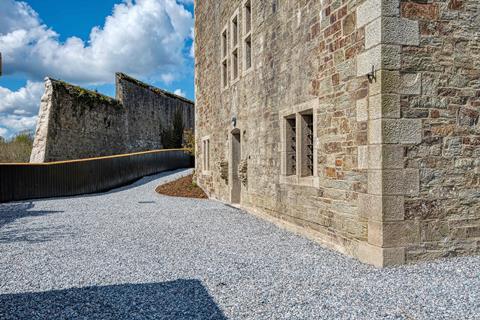
Out in the atrium, the original cantilevered walkways to access the cells were long gone. These were originally supported on slate bearers inserted into wall sockets, but the ones at lower level had been snapped off for salvage. The new steel walkways were also to be cantilevered using steel beams. The minute the team started drilling to create the sockets for the beams, they ran into problems.
“When we drilled the core hole, we hit a historic flue in the atrium wall – and we were hitting them everywhere,” Greene says. He adds that he took to wearing a different, flamboyantly coloured shirt each day to try to cheer up the demoralised team.
The acute nature of the problem meant the walkway structure had to be redesigned by inserting columns against the walls from which the steel beams could be supported to eliminate the need to drill into the wall. The services were originally going to run along the walkways, but the design was changed to run these through the rooms to help with the sequencing.
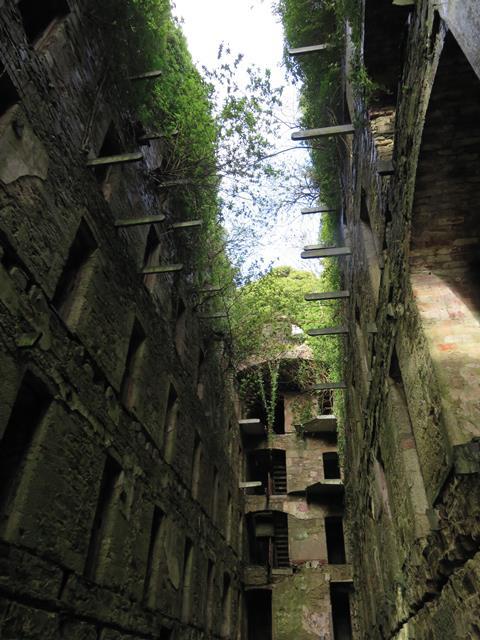
Damage from the explosives had to be patched up and the walls were repaired and pointed as necessary. Greene and Nick Sheward, TPI’s senior project manager, reckon about half the job was works to the building structure.
Originally the hotel had grilles in the outer walls through which fresh air was drawn into ducts in the stone leading to the unusual chimney at the junction of the two wings. Unfortunately it wasn’t possible to reuse this, so the rooms are naturally ventilated with opening windows. A small fan coil unit provides heat and cooling.
The building needed a new roof, which features a steel frame with a timber secondary structure covered with a phyllite from Argentina – a material that resembles slate but is much harder. Each atrium is topped by a steel-framed skylight.
Greene says the most fiddly aspect of this part of the job was getting the length of the primary steel rafters right because the walls were not parallel. Each rafter had to be exactly the right length to ensure that the steel-framed skylight would fit.
Fitting triple-glazed windows to each cell was also fiddly. The openings varied in size, which meant these had to be built out so the windows would fit. The bars on the outside of the windows couldn’t be touched because of the listing, so new units had to be fitted from the inside. Greene says sealing around the windows with the bars in the way was particularly challenging, making it a frustrating job for the sealant specialist.
The lack of a roof for the best part of a century meant the walls were saturated with water. The new roof enabled the drying-out process to start, with the team estimating the one metre-thick walls would take four years to dry out. An insulating lime plaster was applied to the external walls as this allows the walls to breathe and dry out and eliminated the risk of voids between the insulation and the walls.
Elsewhere, the stone has been left exposed and protected with a clear Keim sealant to stop dust coming out of the walls. This had to be applied at a moisture level of 20% or below, which was achieved using the heating system. TPI say the client accepts the bedrooms could take years to dry out with the consequential risk of damp damaging the furniture and timber flooring.
What’s the hotel like?
The first impression of the hotel is one of high granite walls punctured by tiny, barred windows which gives it a somewhat severe and forbidding face. The car park echoes this utilitarian look with areas of blacktop punctuated by gravel parking bays, which are there to help drain Bodmin’s prolific rainfall away.
The entrance is marked by a simple canopy with heavy chains hanging down between the slender stainless steel columns supporting it – these reinforce the prison theme and serve a practical purpose by guiding rainwater off the canopy roof into the drains.

Once inside, the atrium is the prison’s pièce de résistance. Long, narrow and high, this extends over four levels to the glass lantern topped roof. There are three levels of hotel bedrooms accessed off simple steel walkways fixed to the sides of the atrium. The original walls are rough cast, and textured light floods down from the glass lantern above.
At night, the atrium takes on a more eerie quality as it is dimly lit by uplighters atop the columns supporting the walkways. Strong winds generate an ethereal, whistling noise in the roof which only serves to heighten the somewhat spooky atmosphere
Each bedroom is formed from three cells – the entrance door to each is painted bright yellow with the secondary doors, which are no longer used, painted grey. These are originals reclaimed from Wandsworth Prison, which now features steel doors.
Inside the bedroom walls are exposed stone with white-painted lime render reserved for the external wall. The arched ceilings are also exposed stone although some rooms featured rendered ceilings. The floor coverings are a mix of carpet in the bedroom area, timber in the entrance area and stone-look ceramic tiles in the bathroom which extend halfway up the walls to protect them. The rooms are simply decorated and comfortable, while the bathrooms are fitted out with modern sanitaryware and brassware.
CField sourced most of the labour needed for the job locally. Some of the team, including Greene, had to stay in Bodmin during the project as most of the work took place during lockdown, which meant they couldn’t get home regularly to their families.
“A lot of the staff were staying five, six, seven weeks at a time whereas they would normally do two weeks on and a weekend off,” Seward says. “It was very important for us as a team to keep the relationships positive as it was very difficult for the guys locked away down there.”
Most of the work took place during the covid-19 pandemic. Strict protocols were put in place to manage infection risk; this included ensuring social distancing was observed, staggered breaks, temperature checks on arrival at site and a rule stating that anyone who didn’t feel well stayed at home. A full-time covid compliance officer was employed to ensure people stuck to the rules.
This diligence paid off: there was just one covid case during the job. The site was closed immediately but opened again later that day once the whole place had been disinfected. The people who had been working closely with the infected person went off site for 10 days, only coming back after negative tests.
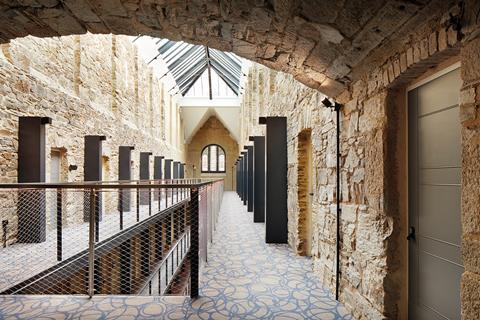
The hotel was ready for handover in March but will not been able to open until the lockdown restrictions end. Originally scheduled to finish in October last year, a considerable amount of extra work has been added, including a bigger and grander restaurant than originally planned, a kitchen, a champagne bar, a gym and a car park.
Hall says the multiple challenges presented by the job meant it could have been a contractual disaster. “It would have provided the perfect canvas for there to be an adversarial relationship between the client and the contractor,” he says. “But what happened is that everybody realised that we had to overcome the building – and do it by working together. This building is the success that it is because we all worked together as a team.”
This sentiment is echoed by Cox. “It has taken longer than we wanted it to and it cost more than we wanted it to, but we are so pleased with the end product,” he says. The people of Bodmin will also benefit. Not only is the future of their distinctive landmark assured but it should widen the appeal of the town well beyond its immediate borders too.
Project team
Client Mallino Development Group
Architect Twelve Architects & Masterplanners
Project manager, employers agent and quantity surveyor Total Project Integration (TPI)
Structural and services engineer Arup
Museum consultant and fit-out contractor Sarner International
Ecologist Plan for Ecology
Hotel contractor CField Construction
Visitor shell and core contractor PIN CM




























No comments yet